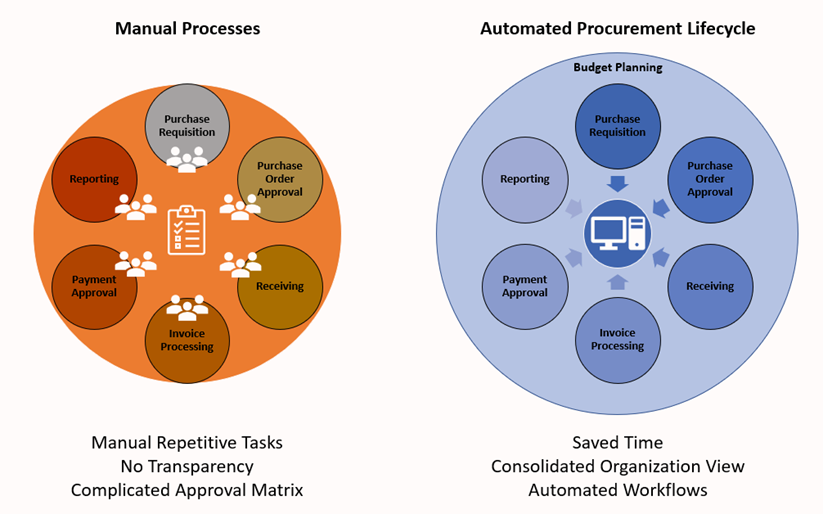Don’t leave money on the table! In addition to more transparent spend analytics, an automated procurement process can result in improved spend control, reductions in cycle times and always-desirable cost savings. Beyond this, organizations can benefit from the opportunity for more focused strategic decision-making in relation to supplier sourcing and contracting.
In this blog, we discuss the digital transformation of selected procurement activities through a best practice lens. In addition, we will provide actionable examples to show how Microsoft Dynamics 365’s (D365) procurement capabilities can support those best practices. (Note, this blog was written before the late July, 2021 Microsoft acquisition of Suplari. We will be following up with an update on how organizations can leverage Suplari to support their procurement transformation.)
Become a strategic player
Procurement cycle optimization focuses on saving time and resources for processes that are typically burdensome when handled manually or through decentralized systems. Here are three examples of key business practices to improve procure-to-pay process efficiency and become more strategic in procurement business decisions.
Optimize supplier management
Supplier management is a key strategic competency for any organization’s procurement department. After developing a sourcing strategy and negotiating supplier contracts, appropriate key performance indicators for continuous monitoring are required to assess supplier performance and compliance. Microsoft D365’s centralized platform, where all business activities can be conducted within a unified data model, can provide various supplier performance metrics related to delivery, quality and cost savings realization from contract agreements. Microsoft offers robust analytical tools such as Power BI that are easily integrated with Microsoft D365 to create comprehensive dashboards and supplier scorecards. This allows decision-makers to quickly and easily assess critical aspects of a supplier’s performance, which can be leveraged during supplier negotiations to create added value — directly impacting the company’s bottom line.
Increase spend control
As external spend amounts to roughly 30 to 70 percent of a company’s total costs, clear visibility into the expenses of both direct and indirect spend categories is imperative to understand where overspending is occurring. Budget planning ensures resources are allocated appropriately to support the strategic objectives of the business. If done at a proper level of granularity, a budget communicates the priorities of the business and effectively restricts any unplanned spending. Using Microsoft D365, budget plans are defined based on organizational hierarchy to support various budgeting methods and allow for spend control down to various levels of granularity such as specific business units/departments.
Throughout the procurement cycle, continuous management of a budget plan is crucial to ensure proper spend control. Establishing a framework to consistently monitor actual spend versus budget allows for organizations to responsively react to live information. D365 allows for strategic implementation of controls and informative reporting, such as predictive reporting to forecast a surpass in budget based on planned demand and/or project forecasts.
Eliminate the manual
What’s bogging down your procurement practice? Organizations with less mature procurement functions commonly struggle with significant manual effort related to communication, approvals, and effectively distributing and storing documents. The good news is there are solutions to both integrate external suppliers and improve internal operations.
Microsoft D365, combined with a supplier portal delivered through Microsoft’s Power Apps, allows the automation of common procurement-related activities. Microsoft’s Power Apps allows companies to create an externally facing business-to-business (B2B) website to support a variety of business interactions. For example, a portal can be used to give a supplier access to its account information, purchase order history, as well as invoice and payment status. In addition, supplier can submit purchase order confirmations and invoices directly into Microsoft D365. The portal may also be used to request information or distribute documentation to suppliers to facilitate ongoing supplier maintenance and compliance reporting.
For internal operations, employees should be able to find and request product or services they need quickly. Microsoft D365 provides a streamlined purchase requisition process in which employees may select from product catalogs and submit their request directly for approval. Purchase approval workflows in D365 can be mobile device enabled allowing managers to process approvals efficiently. From there, the procurement department can create and distribute purchase orders in a timely fashion.

Manual vs. automated procurement process comparison
As successful organizations grow, the need for more advanced automated procurement capabilities is increasingly valuable. Protiviti’s Technology Consulting practice provides a variety of offerings related to this effort including Microsoft D365 software implementation, business process redesign, supply chain/procurement business and technical expertise, and specialized assistance to support analytic solutions for improved reporting and management control.
If you would like to learn more about how to select an application that best supports your organization’s digital transformation, please reference Protiviti’s Procurement Is a Key Player in Digital Transformation Initiatives and System Selection Matters blog post.
To learn more about Protiviti’s procurement and enterprise application solutions, contact us.







